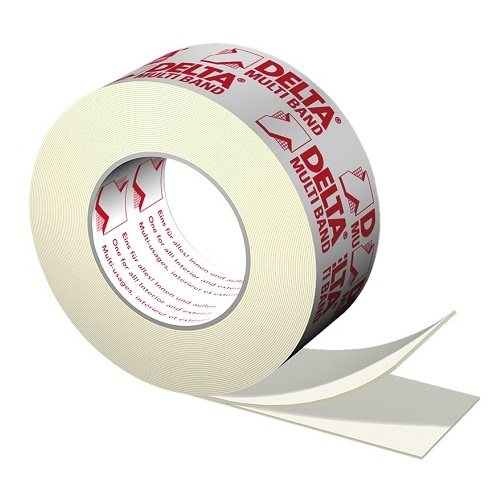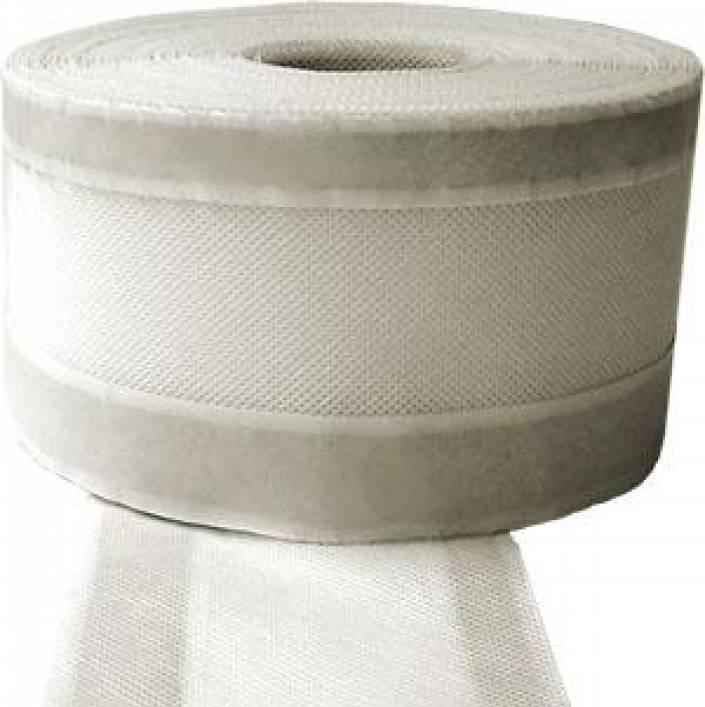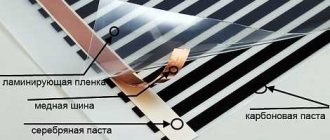In the construction of various objects, a tape made of bitumen or butyl rubber is often used, its main purpose is waterproofing various structures.
Quite often, it is used when installing windows and doors, installing roofs, at the joints of floors and ceilings with walls, for corners. There are tapes of various manufacturers on the market, but their basic parameters are similar.

The structure of the waterproofing tape
Structure:
- Outside, the film is most often covered with aluminum foil, which is represented by a reinforced structure, but there are also tapes on the market based on other materials, as well as in various colors.
- It is based on a layer of bitumen or butyl rubber, which easily adheres to any surface and at any angle.
- From above, the material is covered with a special protective film, its task is to prevent the tape from sticking and drying itself.
Install the film on a specially prepared and cleaned surface.
When carrying out waterproofing work in the places of installation of door and window blocks, the tape should be glued before the complete expansion of the construction foam occurs, this will allow the material to fully stretch and fix tightly.
The price of this product depends on both its width and the manufacturing company.
To choose a waterproofing material from a variety of proposals, familiarization with its various types of structure and application will help.
Outer tape
When installing waterproofing using a special tape, outside buildings, one is used that has increased strength to mechanical stress and temperature extremes. Self-adhesive waterproofing tape "Nikobend" is made specially for use in the installation of PVC windows, it is based on polypropylene.
PVC window tape, the main characteristics of self-adhesive: highly durable, butyl-based, has excellent adhesion to surfaces of any material.
Window tape does an excellent job of protecting against various moisture; its use makes it possible not to use expensive sealants. Window tapes, a functional feature of these films is its ability to remove condensate that settles on the building foam, as well as to prevent moisture from entering the premises from the outside.


Outdoor work on gluing tape
"Tape-PSUL". It has similarities with foam rubber, copes well with excess moisture, which is formed during the full formation of the foam used for installation work on the installation of door and window blocks.
A distinctive feature of this product is its foam protection from direct sunlight. In addition, due to the reliable protection of the foam, there is no urgent need to plaster door and window slopes, and this allows them to be installed even at negative air temperatures. Great for window mounting.
Quality characteristics of the material ↑
The waterproofing tape is made of polyester knitted fabric covered with thermoplastic elastomer. The mesh structure of the base is specially designed for excellent fixation in the sealing compound. The material protects well from moisture and can take any shape necessary for optimal results.
In addition, the tape:
- has high elasticity even at low temperatures;
- resistant to microorganisms and aging;
- withstands high water pressure;
- easy to install;
- resistant to aggressive environments;
- environmentally friendly;
- suitable for indoor and outdoor use.
Interior tape
When carrying out waterproofing work inside the premises, a diffuse tape is used, it is she who will block the ingress of moisture from the side of the mounting foam inside.
Italian waterproofing vapor-permeable tape "Plaster", has excellent performance in terms of reliability and durability, and also sets high criteria for moisture and steam protection. It is based on a special bitumen tape reinforced with special polyethylene. From the outside, it is covered with aluminum foil, adhesive strips, have silicone protection, and its thickness is one and a half millimeters.
The scope of this tape is not limited to any of the building materials; it adheres perfectly to concrete, ceramic, cement and other walls. Available in four different colors of the outer film, it can also be easily painted in any color. On sale there are rolls from five to ten meters long, and the width can range from five to fifteen centimeters.
It might be interesting
Thermal insulation
Distinctive features and variety of ceiling tiles ...
Thermal insulation
How to insulate the ceiling in a wooden house?
Thermal insulation
What is a heating cable?
Thermal insulation
Warm "pie" for a metal chimney


Internal work on gluing tape
Polyurethane joint sealing tape "Masterflex", it is distinguished by elasticity, resistance to mechanical stress, high protection against the ingress of water under pressure. When installing this film, the contact surfaces need careful processing, but at the same time it is not selective to their composition. This tape is easily glued to surfaces with high humidity, but for excellent tension and adhesion, you can fix it with nails at a distance of twenty to twenty-five centimeters. Seams are sealed with this material.
Roofing tape "Ecobit", is used for waterproofing the roof, and its area of application is not limited only to this, it is successfully used when installing windows, pipes and doors. Tape for plastic windows is completely uncritical in the choice of materials on which it will be glued.
It is distinguished by its reinforced reinforced layer and outer aluminum or copper coating. Outside, the tape is protected by polyester, reaches thirty centimeters in width, covered with a silicone film, fixed on any cleaned surface, and porous ones need to be treated with special primers.
Butyl rubber waterproofing tape for windows "Liplent", the place of application is internal window slopes.
There are three types of such tape on the market:
- It is based on polyethylene, fiberglass as a reinforcement, covered with aluminum foil from the outside. Butyl sealant, acts as a mite layer.
- Waterproofing tape, the main composition is butyl sealant.
- Knauf has excellent elasticity, is made of polyester, has a long service life, and is used as a hydr insulator in various facilities.
Positive and negative sides of the material
Self-adhesive border tape for the bathroom, user reviews about themselves are mostly positive. After all, such a decor has a lot of advantages. The main advantages of this material are as follows:
- affordable cost;
- quick and easy installation;
- versatility;
- good resistance to stress and mechanical damage;
- sufficient strength and hygiene;
- attractive appearance.
All of the above properties are not an exhaustive characteristic of such a decor, but explain its popularity. In addition, polymer sealing strips are resistant to moisture and high temperatures, which is so important for their use in the bathroom. They are very elastic, so they can be used not only on rectangular, but also round bath configurations. At the same time, the joint line looks effective and neat.
An important nuance will be the possibility of self-assembly of the tape. This does not require special knowledge or experience of such work. Even a person ignorant of the construction business who does not have a professional set of tools can reliably seal the joint.
The resistance of such a product to the effects of chemicals, so often used to clean the bath, received excellent reviews. The top layer of the coating does not react with aggressive elements. Accordingly, it does not lose its aesthetic appearance and functionality throughout its entire service life. In addition, even with minor surface damage, the tape will remain firmly attached and will not delaminate.


Of course, with all the indisputable advantages, these decorative stripes also have negative characteristics. The first thing to mention is the fragility of such a material. Manufacturers usually provide a one-year warranty for the product, although in some cases, with careful handling, the tape will last up to five years.
The second negative property will be the ability to react with acid-based substances. This can lead to the loss of the original attractive appearance and even peeling of the curb. Therefore, you should not abuse such products when cleaning the bathroom.
In short, sealing the gap with self-adhesive tape is an effective and reliable, but temporary measure. Although, given the democratic cost of the material, it will not be difficult to periodically replace the old decor with a new one.
Waterproofing tapes
Material:
- Comfort tape. It is a diffuse waterproofing agent that absorbs moisture and then removes it.
- "Titanium" is characterized by excellent protective properties, resistant to temperature fluctuations, and consists of polyester material. Possesses both moisture and heat insulating properties, when glued it creates a continuous coating.


Delta Ribbon
Basics of using waterproofing tape.
Before using any waterproofing tape, it is necessary to thoroughly prepare the surface, since the quality of adhesion and service life depend on this. All listed materials are recommended for use. They are used for sealing works in bathrooms, swimming pools, various tanks, roofs and maintenance systems, as well as for sealing cracks in walls, joints and joints.
The common distinguishing feature of these tapes is their ability to perfectly interact with various types of building surfaces, as well as those treated with adhesives, mastics and paints.
Before using, you should select the tape that fits in width, determine the required length, remove the protective film and press the tape to the beginning of the joint, gradually spreading it over the entire surface, additionally pressing it with a special roller, trying to remove all the air. Only after this is the polyurethane foam applied, after the complete expansion of which the tape is finally fixed and stretched.
It is important to remember that in the corners of deformation, the tape is applied in the form of an omega loop. Also, the tape is applied wider than the joint by about six centimeters. The second layer is laid along the edges of the tape, leaving the middle free, while the bottom layer should already be under the dried one.
By following the steps outlined above, you should be able to create a great waterproofing joint.
General installation features ↑
Before installing any tape, you need to make sure that the base is well cleaned of dirt, dust, grease and oil stains, old paint and other possible poorly adhering layers. A layer of waterproofing mortar is applied to the surfaces adjacent to the joint, or to the areas of inlets of drains and communications. It should be borne in mind that the application area should be increased by several centimeters compared to the width of the material. All floor and wall cuffs, inner and outer corners and other necessary accessories must be installed prior to the insulation cover.
The tape is cut and placed in a wet layer of waterproofing so that it completely covers the joint. The coating is gently pressed into the substrate with a smooth trowel until all air bubbles are removed. In the expansion joints, the material is laid in the form of a special "omega" loop. All joints of corner elements, tapes and cuffs must be overlapped by 7 cm. The waterproofing layer is again applied over the perforated part of the tape, so that the middle part remains uncoated. In this case, the previous layer of waterproofing should be wet, but already hardened.






















